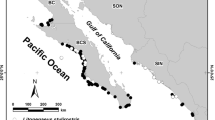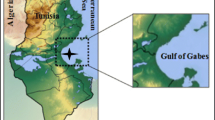Abstract
The levels of mercury in tissues of Penaeus merguiensis from Musa estuary, northwest of the Persian Gulf, were investigated. This study assessed the relationship between mercury levels in hepatopancrea, gill, and muscle with sex, size, and season. The order of mercury concentrations in tissues of the shrimp P. merguiensis was as follows: hepatopancreas > gill > muscle. There was a positive correlation between mercury concentrations in shrimp species with sex and size of its food items. We expected to see higher mercury levels in tissues of female species because they are larger and can eat larger food items. Also, there was a positive correlation between mercury concentrations in shrimp species with its food source. Therefore, female species feed more on shrimp and plant and are contaminated with high levels of mercury. There was significant difference (p < 0.05) in mercury levels between different seasons; higher mercury levels were found in July (summer season).




Similar content being viewed by others
References
Abdolahpur, M. F., Peery, S., Karami, O., Hosseini, M., Bastami, A. A., & Ghasemi, A. F. (2012). Distribution of metals in the tissues of benthic, Euryglossa orientalis and Cynoglossus arel and Bentho-Pelagic, Johnius belangeri, fish from three estuaries, Persian Gulf. Bulletin of Environmental Contamination and Toxicology, 18, 319–324.
Beckvar, N., Field, J., Salazar, S., & Hoff, R. (1996). Contaminants in aquatic habitats at hazardous waste sites: mercury. Seattle: NOAA.
Bordin, G., Mc-Court, J., & Rodriquez, A. (1992). Trace metal in the marine bivalve Macoma balthica in the westerschelde estuary the Nerthlands. Part 1: analysis of total copper, cadmium, zinc and iron concentrations; local and seasonal variations. Science of the Total Environment, 127, 255–280.
Bu-Olayan, A. H., Mohammed, H. M. A., Subrahmanyam, M. N. V., & Thomas, B. V. (1998). Effect of size upon metal content of lobster (Thenus orientalis) from the Kuwait marine environment. Bulletin of Environmental Contamination and Toxicology, 61, 175–181.
Burger, J., Gochfeld, M., Jeitner, C., Burke, S., Stamm, T., & Snigaroff, R. (2007). Mercury levels and potential risk from subsistence food from the Aleutians. Science of the Total Environment, 384, 93–105.
Bustamante, P., Bocher, P., Cherel, Y., Miramand, P., & Caurant, F. (2003). Distribution of trace elements in the tissues of benthic and pelagic fish from the Kerguelen Islands. The Science of the Total Environment, 313, 25–39.
Canli, M., & Furness, R. W. (1993). Heavy metals in tissues of the Norway lobster Nephrops norvegicus: effects of sex, size and season. Chemistry and Ecology, 8, 19–32.
Elahi, M., Esmaili-Sari, A., & Bahramifar, N. (2011). Total mercury levels in selected tissues of some marine crustaceans from Persian Gulf, Iran: variations related to length, weight and sex. Bulletin of Environmental Contamination and Toxicology, 88, 60–64.
Farkas, A., Salanki, J., & Specziar, A. (2003). Age and size-specific patterns of heavy metals in the organs of freshwater fish Abramis brama L. populating a low-contaminated site. Water Research, 37, 959–964.
Fitzgerald, W. F., Lamborg, C. H., & Hammerschmidt, C. R. (2007). Marine biogeochemical cycling of mercury. Chemical Reviews, 107, 641–662.
Francesconi, K., & Lenanton, R. C. J. (1992). Mercury contamination in a semi-enclosed marine embayment: organic and inorganic mercury content of biota and factors influencing mercury levels in fish. Marine Environmental Research, 33, 189–212.
Gewurtz, S. B., Bhavsar, S. P., & Fletcher, R. (2011). Influence of fish size and sex on mercury/PCB concentration: importance for fish consumption advisories. Environmental International, 37, 425–434.
Hosseini, M., Nabavi, S. M. B., Bastami, A. A., & Parsa, Y. (2012). Mercury concentration in tissues of blue swimming crab, Portunus pelagicus (Linnaeus, 1758) and sediments from Persian Gulf coasts, Iran. World Applied Sciences Journal, 18(3), 322–327.
Houserova, P., Kuban, V., Spurny, P., & Habarta, P. (2006). Determination of total mercury and mercury species in fish and aquatic ecosystems of Moravian rivers. Veterinární Medicína, 51, 101–110.
Kargın, F., Donmez, A., & Cogun, H. Y. (2001). Distribution of heavy metals in different tissues of the shrimp Penaeus semiculatus and Metapenaeus monocerus from the Iskenderun Gulf, Turkey: seasonal variations. Bulletin of Environmental Contamination and Toxicology, 66, 102–109.
Mieiro, C. L., Pacheco, M., Pereiraa, M. E., & Duartea, A. C. (2009). Mercury distribution in key tissues of fish (Liza aurata) inhabiting a contaminated estuary-implications for human and ecosystem health risk assessment. Journal of Environmental Monitoring, 11, 1004–1012.
Mooraki, N., Sari, A. E., Soltani, M., & Valinassab, T. (2009). Spatial distribution and assemblage structure of macrobenthos in a tidal creek in relation to industrial activities. International Journal of Environmental Science and Technology, 6, 651–662.
Mourente, G. (1996). In vitro metabolism of 14C-polyunsaturated fatty acids in midgut gland and ovary cells from Penaeus kerathurus Forskal at the beginning of sexual maturation. Comparative Biochemistry and Physiology, Part B: Biochemistry & Molecular Biology, 115, 255–266.
Navarro, M. C., Perez-Sirvent, C., Martınez-Sanchez, M. J., Vidal, J., & Marimon, J. (2006). Lead, cadmium and arsenic bioavailability in the abandoned mine site of Cabezo Rajao (Murcia, SE Spain). Chemosphere, 63, 484–489.
New, M. B., Valenti, W. C., Tidwell, J. H., Abramo, L. R. D., & Kutty, M. N. (2010). Freshwater prawns: biology and farming. Hoboken: Blackwell Publishing Ltd.
Nolting, R. F., Dalen, M., & Helder, W. (1996). Distribution of trace and major elements in sediment and pore waters of the Lena Delta and Laptev Sea. Marine Chemistry, 53, 285.
Ozden, O., (2010). Seasonal differences in the trace metal and macrominerals in shrimp (Parapenaus longirostris) from Marmara Sea. Environmental Monitoring and Assessment, 162, 191,199. 299.
Phillips, G. R., Lenhart, T. E., & Gregory, R. W. (1980). Relation between trophic position and mercury accumulation among fishes from the Tongue River reservoir. Environmental Research, 22, 73–80.
Pourang, N., Nikouyan, A., & Dennis, J. H. (2005). Trace element concentrations in fish, surficial sediments and water from northern part of the Persian Gulf. Environmental Monitoring and Assessment, 109, 293–316.
Risher, J. F. (2003). Elemental mercury and inorganic mercury compounds: human health aspects. Geneva: World Health Organization.
ROPME (1999). Regional report of the state of the marine environment. Regional Organization for the Protection of the Marine Environment (ROPME), Kuwait, p. 220.
Sen, A., & Semiz, A. (2007). Effects of metals and detergents on biotransformation and detoxification enzymes of leaping mullet (Liza saliens). Ecotoxicology and Environmental Safety, 68, 405–411.
Storelli, M., Barone, G., Piscitelli, G., Marcotrigiano, GO. (2007). Mercury in fish: concentrations as fish size and estimates of mercury intake. Food Additives and Contaminants 24, 1353–1357.
Yi, Y., Wang, Z., Zhang, K., Yu, G., & Duan, X. (2008). Sediment pollution and its effect on fish through food chain in the Yangtze River. International Journal of Sediment Research, 23, 338–347.
Yilmaz, A. B., & Yilmaz, L. (2007). Influences of sex and seasons on levels of heavy metals in tissues of green tiger shrimp (Penaeus semisulcatus). Food Chemistry, 101, 1664–1669.
Acknowledgments
The authors would like to thank Prof. Bahram Kiabi, Prof. Jabar Salamat, Moemen Ali Peery, Akbar Almasi, Hakim, and Latif Monikhi, Dr. Ali Hossein Jalilian, and Dr. Hasan Abdolahpur. This research was supported by the Khoramshahr University of Marine Science and Technology and Environment Protection Institute of Tehran, Iran.
Author information
Authors and Affiliations
Corresponding author
Rights and permissions
About this article
Cite this article
Hosseini, M., Nabavi, S.M.B., Parsa, Y. et al. Mercury accumulation in selected tissues of shrimp Penaeus merguiensis from Musa estuary, Persian Gulf: variations related to sex, size, and season. Environ Monit Assess 186, 5439–5446 (2014). https://doi.org/10.1007/s10661-014-3793-7
Received:
Accepted:
Published:
Issue Date:
DOI: https://doi.org/10.1007/s10661-014-3793-7




